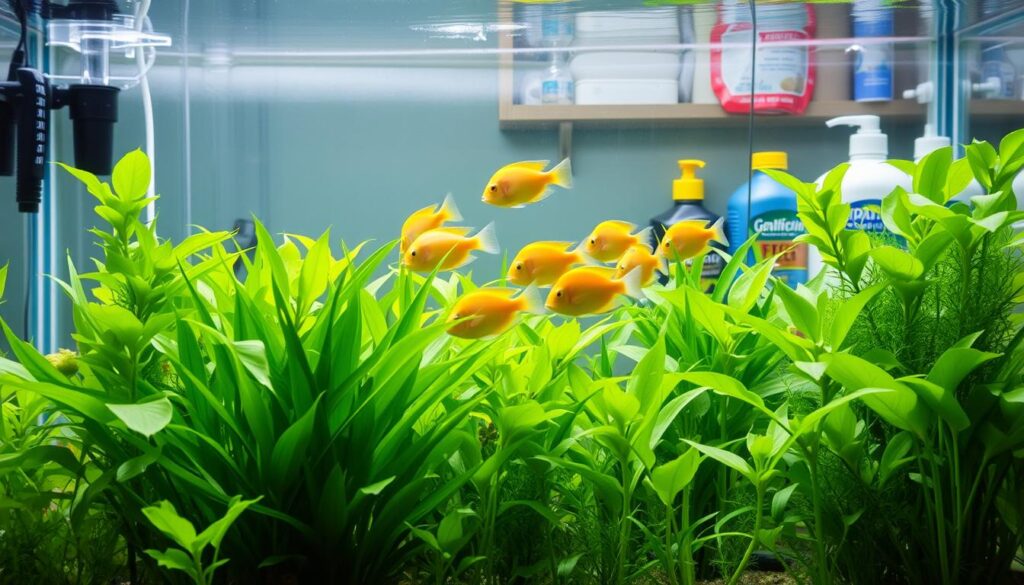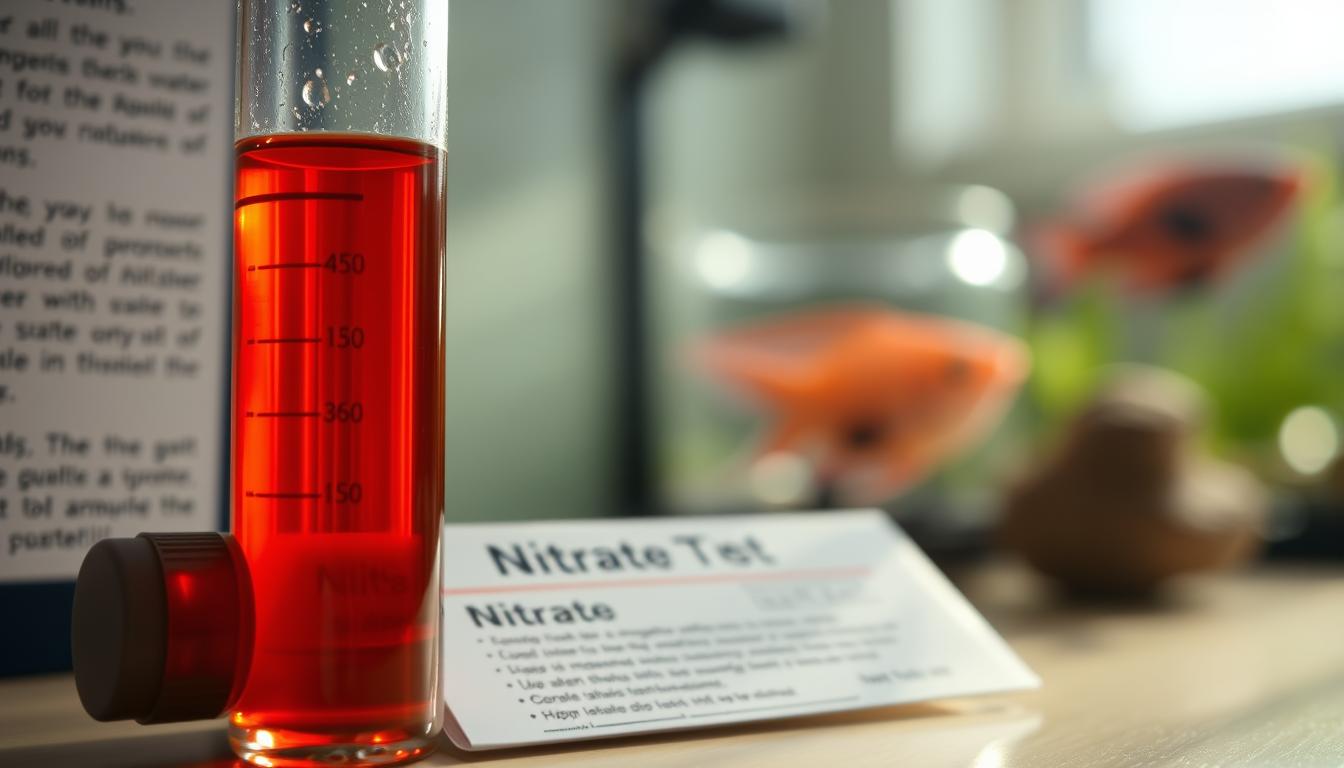Keeping your aquarium clean and safe isn’t just about clear water—it’s about knowing what’s happening beneath the surface. One of the most common but often overlooked problems is high nitrate levels. In this guide, we’ll help you understand the Signs of High Nitrates in Aquarium, so you can take action before it harms your fish. Whether you’re a beginner or an experienced aquarist, knowing these signs can make all the difference in maintaining a healthy underwater environment.
So, how do you spot high nitrate levels in your tank? Knowing the signs is crucial to fix the problem. By spotting nitrate buildup early, you can keep your fish happy and healthy.
Key Takeaways
- Regularly test your aquarium water to detect elevated nitrates.
- High nitrate levels can lead to fish stress and health issues.
- Maintain proper filtration and regular water changes.
- Monitor your fish for signs of nitrate poisoning.
- Balance your aquarium’s ecosystem to prevent nitrate buildup.
Understanding Nitrates in the Aquarium Ecosystem
As aquarium fans, we know about the ‘nitrogen cycle.’ But do we really understand how it affects our tank’s nitrate levels? The nitrogen cycle changes ammonia from fish waste into nitrite and then nitrate. This is key for a healthy tank, but it means nitrates are always present.
The Nitrogen Cycle Explained
The nitrogen cycle is a natural process in all aquariums. It starts with beneficial bacteria turning ammonia into nitrite. Then, other bacteria turn nitrite into nitrate. Knowing this cycle helps us manage nitrate levels better.
Normal vs. Dangerous Nitrate Levels
Nitrate levels vary by aquarium type. For freshwater tanks, safe levels are below 20-40 ppm. Saltwater and reef tanks need levels below 5-10 ppm. High levels can stress fish, harm plants and corals, and worsen water quality. It’s crucial to check nitrate levels often.
Why High Nitrate Levels Are Dangerous
High nitrate levels in your aquarium can be a silent killer. They pose a significant threat to the health and well-being of your aquatic life. When nitrates build up, they can cause a range of problems that can be detrimental to your tank’s ecosystem.
Read Also How to Lower Nitrate in Freshwater Aquarium
Impact on Fish Health and Lifespan
For fish, high nitrate levels can lead to stress, disease, and even death. Nitrate poisoning can cause symptoms such as labored breathing, lethargy, and loss of appetite. Prolonged exposure to high nitrates can weaken your fish’s immune system, making them more susceptible to illness.
This can significantly reduce their lifespan and overall quality of life.
Effects on Plants, Corals, and Invertebrates
While plants can benefit from some nitrates, excessive levels can still cause problems. High nitrates can lead to algae overgrowth, which can outcompete plants for resources and cause an imbalance in the tank. For corals and invertebrates, high nitrates can cause reduced growth rates, stress, and even bleaching.
It’s essential to maintain optimal nitrate levels to ensure the health and vitality of all aquatic life in your tank.
By understanding the dangers of high nitrate levels, you can take steps to prevent and mitigate their effects. This creates a healthier environment for your aquatic life to thrive.
Signs of High Nitrates in Aquarium
Spotting high nitrates in your aquarium can be tricky. But, we’re here to help! High nitrates harm your fish and other sea creatures. So, it’s key to spot the signs early.
Fish Behavior Changes and Stress Indicators
High nitrates can change how your fish act. They might swim less or breathe fast. In bad cases, they could lose their appetite or have trouble breathing.
Watch your fish closely. If they act strangely, it might mean nitrate levels are too high.
Read Also How to Clean a Betta Fish Tank for Beginners
Visual Changes in Tank Water and Surfaces
High nitrates can also make your tank water and surfaces look different. You might see more algae or cloudy water. Also, algae or biofilm might grow on your tank walls or decorations.
Cleaning your tank often and checking the water can help spot problems early.
Plant and Coral Deterioration Symptoms
Live plants or corals in your tank can suffer from high nitrates. They might turn yellow or brown, or lose color. In serious cases, they could even die.
Check your plants and corals often. This way, you can catch any problems before they get worse.
By watching for these signs, you can protect your aquarium. This keeps your fish and sea life healthy and happy.
How to Test for Nitrate Levels Accurately
To keep your aquarium thriving, it’s essential to know how to accurately test for nitrate levels. Testing for nitrates might seem like a chore, but trust us, it’s a crucial step in maintaining a healthy environment for your fish!
Test Kit Options and Reliability Comparison
There are various test kits available for measuring nitrate levels. They range from simple colorimetric tests to more sophisticated electronic meters. When choosing a test kit, consider factors like accuracy, ease of use, and cost. Some popular options include:
- API Nitrate Test Kit
- Seachem MultiTest Nitrate Kit
- Nitrate Ion-Selective Electrode Meters
Let’s compare these options in a handy table:
| Test Kit | Accuracy | Ease of Use | Cost |
|---|---|---|---|
| API Nitrate Test Kit | High | Easy | $10-$15 |
| Seachem MultiTest Nitrate Kit | Very High | Moderate | $20-$25 |
| Nitrate Ion-Selective Electrode Meters | Extremely High | Complex | $50-$100 |
Step-by-Step Testing Process
Regardless of the test kit you choose, the testing process generally involves a few simple steps:
- Collect a water sample from your aquarium.
- Add the test reagent to the sample.
- Wait for the specified reaction time.
- Compare the result to the provided color chart or read the value on your meter.
Interpreting Test Results and Taking Action
Once you’ve obtained your test results, it’s time to interpret them and take action if necessary. Here’s a quick guide:
- Low Nitrates (<10 ppm): Your aquarium is likely healthy, but continue regular testing.
- Moderate Nitrates (10-20 ppm): Monitor closely and consider adjustments to your maintenance routine.
- High Nitrates (>20 ppm): Take immediate action with a water change and review your aquarium’s bioload and filtration.
Common Causes of Nitrate Buildup
Nitrate buildup in your aquarium can be a real headache. But knowing what causes it is the first step to fixing it! You might wonder, what’s making nitrate levels go up? Let’s look at the usual suspects together.
Overfeeding and Excess Organic Matter
One big reason for high nitrates is overfeeding. When you give your fish too much food, the leftovers break down. This process releases ammonia, which turns into nitrates. It’s like leaving a big mess! So, don’t overfeed your fish.
Inadequate Filtration and Maintenance
Inadequate filtration also leads to nitrate buildup. If your tank’s filter can’t handle waste, nitrates will rise. Keeping your filter clean is key to a balanced tank.
Overstocking Your Aquarium
Having too many fish is another problem. More fish mean more waste. An overcrowded tank is like a traffic jam – it’s a mess! Don’t overstock your aquarium to avoid this.
Source Water Contamination
Lastly, source water contamination can raise nitrate levels. If your tap water has high nitrates, it will affect your tank. Use a water conditioner or test your tap water before adding it to your tank.
By knowing these common causes of nitrate buildup, you can prevent it. This will help keep your aquarium healthy and thriving!
Preventing High Nitrate Levels
Keeping nitrate levels in check is simpler than you might think. We’re here to help you understand how to do it. It’s all about following a few key practices to keep your aquarium in top shape.
First off, let’s talk about feeding. Overfeeding is a big no-no that can quickly raise nitrate levels. By only giving your fish what they can eat in a few minutes, you cut down on waste.
Establishing Proper Feeding Routines
To feed right, keep these tips in mind:
- Feed your fish 2-3 times a day, only as much as they can eat in a few minutes.
- Take out any leftover food after 5 minutes to stop it from breaking down.
- Make sure your fish get a varied diet to keep them healthy.
Optimal Filtration and Water Flow
A good filter is key to keeping nitrates low. It removes waste and extra nutrients that can cause nitrates to build up. Make sure your filter fits your tank size and works well.
Here’s a look at different filters:
| Filtration Type | Nitrate Removal Efficiency | Maintenance Needs |
|---|---|---|
| Mechanical Filtration | Low | High |
| Biological Filtration | High | Medium |
| Chemical Filtration | Medium | Low |
Strategic Aquascaping for Nitrate Control
Live plants are not just pretty; they also soak up excess nutrients like nitrates. Adding plants to your tank can balance out your ecosystem.
Some plants are better at taking in nitrates than others. Think about adding Anacharis or Hornwort to your tank.
Beneficial Bacteria and Biological Solutions
Beneficial bacteria are vital for breaking down waste, including nitrates. By encouraging these bacteria, you help keep your tank healthy.
Biological supplements can boost your tank’s biological filtration. They contain bacteria that are good at breaking down nitrates and other waste.

Immediate Solutions for Reducing Nitrates
When nitrates spike in your aquarium, it’s time to act fast. High nitrate levels can stress your fish and harm your plants. They can even cause algae blooms. So, what can you do right away to reduce nitrates and restore balance to your tank?
Emergency Water Change Protocols
One effective way to lower nitrate levels is by doing an emergency water change. We suggest replacing 20-50% of the tank water with fresh, nitrate-free water. This dilutes the nitrate concentration and helps your aquatic life. Make sure the new water’s temperature and chemistry match your tank’s to avoid shocking your fish.
| Nitrate Level | Recommended Water Change |
|---|---|
| 20-50 ppm | 20% water change |
| 50-100 ppm | 30-50% water change |
Chemical Nitrate Removers: Effectiveness and Safety
Chemical nitrate removers can quickly reduce nitrate levels. They absorb or convert nitrates into harmless nitrogen gas. But, use them carefully and follow the instructions. Some removers can change your water chemistry suddenly, so watch your tank’s parameters closely after use.
Temporary Measures While Addressing Root Causes
While taking immediate action to reduce nitrates, it’s also key to find and fix the root causes. Overfeeding, bad filtration, and too many fish are common problems. Adjust your feeding, improve your filtration, or rehome some fish to prevent future spikes. Remember, quick fixes are just temporary. Long-term solutions need a deep understanding of your aquarium’s ecosystem.
Long-Term Nitrate Management Strategies
Managing nitrates is key to a healthy aquarium. We’ll show you the best ways to do it! It’s not a one-time job. You need to keep working at it to keep your tank balanced.
Creating a Sustainable Maintenance Schedule
Having a regular maintenance plan is essential. This means doing water changes, cleaning your filter, and checking the water. By doing these things, you can stop nitrate buildup and keep your tank healthy. Try setting reminders or planning maintenance days to stay on track!
Balancing Your Tank’s Bioload
The bioload is how much waste your tank’s creatures make. To control nitrates, you need to balance this. Avoid overstocking and pick fish that are easy to care for. Make sure your filter can handle the waste too. It’s about finding the right balance for your tank to thrive.

Monitoring Technologies and Tools
Using the right tools can really help with nitrate management. From nitrate test kits to advanced water quality monitors, these tools give you important information. With this info, you can make quick changes to keep nitrate levels in check.
| Tool/Technology | Description | Benefit |
|---|---|---|
| Nitrate Test Kits | Simple, cost-effective way to measure nitrate levels | Easy to use, provides quick results |
| Water Quality Monitors | Advanced devices that continuously monitor water parameters | Real-time data, alerts for changes |
| Aquarium Management Apps | Digital tools to track maintenance, water changes, and more | Helps maintain a consistent schedule, reminders |
Special Considerations for Different Aquarium Types
Different aquariums need special care when it comes to nitrates. Whether you have a freshwater, saltwater, planted, or reef tank, knowing the differences is crucial. This knowledge helps keep your aquarium healthy.
Freshwater vs. Saltwater Nitrate Thresholds
Freshwater and saltwater tanks have different nitrate tolerances. Freshwater fish can handle higher nitrate levels than saltwater fish. For freshwater tanks, safe nitrate levels are below 20-40 ppm. Saltwater tanks need levels below 5-10 ppm. It’s important to control nitrate levels for your fish’s health.
| Aquarium Type | Safe Nitrate Levels (ppm) |
|---|---|
| Freshwater | 20-40 |
| Saltwater | 5-10 |
Planted Tanks as Natural Nitrate Filters
Planted tanks are not just pretty; they also clean the water naturally. Plants like Anacharis or Hornwort absorb nitrates. Adding these plants helps balance your tank’s ecosystem.
Reef Tanks and Ultra-Low Nitrate Requirements
Reef tanks, home to corals and invertebrates, require very low nitrates. High nitrates can cause algae, which harms corals. To keep your reef tank healthy, aim for nitrate levels below 1-5 ppm. Regular water changes and efficient filtration are key.
“The key to a successful reef tank is maintaining ultra-low nitrate levels. It’s a challenging task, but with the right strategies and equipment, it’s achievable.” – Reef Tank Expert
Understanding your aquarium’s specific needs helps manage nitrates effectively. This ensures a healthy environment for your aquatic life.
Real-Life Case Studies: Solving Nitrate Problems
Let’s explore some real-life examples of solving nitrate problems in aquariums. These stories will give you insights into managing nitrates in your tank.
Community Tank Nitrate Reduction Success Story
A community tank owner was dealing with high nitrate levels, stressing their fish. They fixed this by changing water regularly and adding more plants. The secret was consistent monitoring and adjusting the tank’s balance.
They also cut down on overfeeding, a big nitrate contributor. This move improved fish health and made the tank more sustainable.
Reef Tank Nitrate Management Transformation
A reef tank owner battled nitrate buildup, harming their corals. They used chemical nitrate removers and biological solutions like beneficial bacteria. This mix greatly reduced nitrate levels.
The corals’ health and color improved dramatically. This case shows the power of mixing different nitrate management strategies in reef tanks.
Conclusion: Maintaining Optimal Nitrate Levels for a Healthy Aquarium
Keeping nitrate levels right is key for a healthy aquarium. We’ve looked at why nitrates matter, how to spot high levels, and how to lower them. By following these tips, you can make a great home for your fish and plants.
Keeping your aquarium in top shape means regular checks and upkeep. This includes changing water, feeding right, and making sure filters and water flow are good. Being active helps stop nitrate buildup and keeps your tank balanced.
Different tanks need different care. Whether it’s a freshwater, saltwater, or reef tank, knowing what your tank needs is crucial. By using the advice from this article, you’ll be able to keep nitrate levels in check. This will help you enjoy a lively and healthy aquarium.

